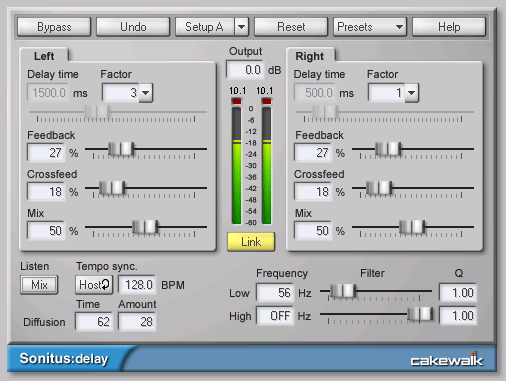Sonitus fx:delay
Last updated on 3/18/2016by Michael Nickolas
We sure have it easy these days. The first uses of delay effects required tape machines and were done by mixing a tape delayed version of the original signal back into the song (and you had to walk five miles uphill both ways in the snow to do it!). Shortly after this, stand alone tape delay effect units came into existence. These were simply a box containing a looping tape reel. Delay times were set by increasing or decreasing the distance between the record and play back heads.
In the 1970’s analog delay was introduced, no tape involved. How this worked was the incoming signal was split in two. One was sent directly to the output and one was held back by passing it through a series of electronics. Unfortunately, this technique not only created a delayed signal but added a lot of noise. Still, they became popular being much smaller and easier to maintain than their tape predecessors.
Fast forward to the 1980’s when the first hardware digital delay units were introduced. Digital delays use computer chips to accomplish the delay. Essentially storing a copy of the original signal in memory and releasing it after an interval of time.
So as I was saying, we have it easy these days. We simply can incorporate the Sonitus Delay on an aux bus or as a track insert, and voila, instant delay!
The Sonitus Delay sports an orderly user interface incorporating distinctive features. It is a stereo delay with a range of 0.1 to 4000 ms. Settings for the left and right can be totally independent of each other. The Sonitus Delay can automatically calculate it’s delay times based on the tempo of your song! No more breaking out a calculator or running a separate program to figure out how many milliseconds equal an eighth note! There are even low/high filters available so you can do some basic EQing on the repeats right from within the plug-in!
Here is an example of how to use the Sonitus Delay on a SONAR track insert, have it automatically figure musical delay times and manually EQ the repeats.
- Insert the Sonitus Delay onto the desired tracks effect bin.
- Click the reset button.
- Change the Tempo sync button from “Man” (manual) to “Host”.
- Press play in SONAR and let the song run for a second. The Sonitus Delay will put the proper tempo in to the BPM box and the left and right delay times will be set to equal a quarter note repeat (meaning the original signal will be delayed exactly the length of a quarter note before being repeated).
- Set the left and right delay times as you wish by changing the Factor for each. For example changing from a factor of 1 to a factor of ½ will change the signal from repeating every quarter note to every eighth note. The left and right delay factors can be set independently. Factors ending in 3, 6 and 12 will generate triplet figures.
- Adjust the Feedback percentage to your liking. This is the setting that controls the amount of repeats that happen before they fade out. If the Link button is enabled, dragging one channels feedback slider moves the others simultaneously. The Feedback percentages can be adjusted independently by un-selecting link.
- Adjust the Mix percentage to your liking. This setting controls the volume of the repeats in comparison to the original signal. Remember a little bit goes a long way when adding effects to a signal. I usually set the mix of an effect (like delay or reverb) to where I think it sounds really good, then I back it off just a bit to be sure I am not overdoing it.
Next, you may want to apply some EQ to the repeats. For example, a popular production technique is to delay a vocal signal and thin out the repeats a bit. This can be done using the Sonitus Delay’s low and high filters. Drag the low frequency slider to the right and you will see the Hz reading change in response. As you drag it, frequencies below the number being display will be attenuated. The same is true for the high filter except in reverse. As you drag left, frequencies above the number being displayed will be attenuated. Changing the “Listen” setting from Mix to Delay removes the original signal from the output allowing you to concentrate on the sound of the repeats only. Figure 1 shows a setting that gives a thin or “telephone” sounding type of EQ. Also note the independent left and right delay times. The factor of ½ on the left is giving eighth note repeats. The factor of ¼ on the right is giving sixteenth note repeats.

Figure 1
Often times it is desirable to have a repeat happen only at certain times, for example on a single word of a vocal performance instead of on the entire performance. This can be accomplished in SONAR using the Sonitus Delay and automation.
- In the tracks effect bin, right click on the Sonitus Delay and choose “Arm Parameter”.
- Put a check mark next to “Mix L” and “Mix R”.
- Open the Sonitus Delay plug-in.
- Begin play back of the song by clicking on SONAR’s Transport “record automation” button.
- Adjust the Mix settings in real time, with 0% meaning no delayed signal present at the output.
When you’re done, you’ll see an automation envelope has been created for the track. Fine tune this envelope to achieve exactly the results you are looking for.
So don’t delay! (sorry, couldn’t help myself). Jump in and take advantage of all the great features this powerful plug-in has to offer!
Michael Nickolas is a guitarist and composer in Marlborough MA. Recent compositions have been used on CBS's "JAG" and ShowTime's "Soul Food". Visit him at www.studionineproductions.com. Email to michael@studionineproductions.com